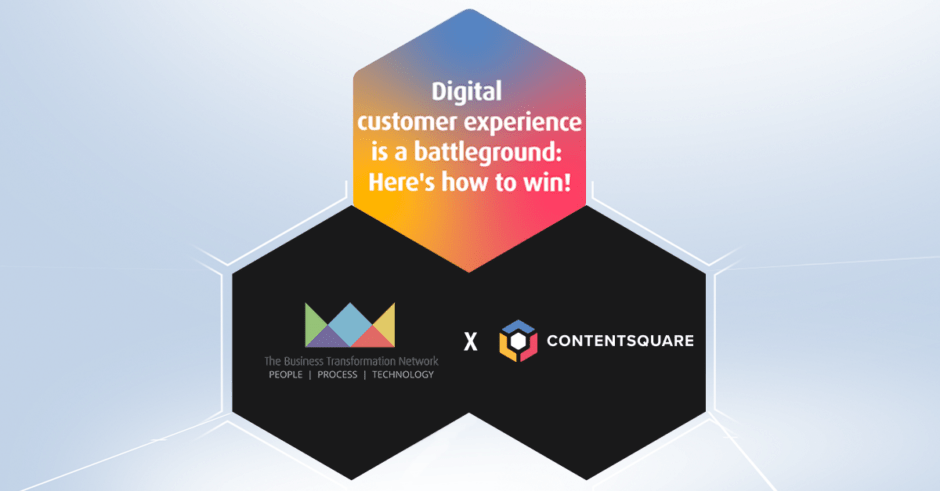The digital landscape has rapidly scaled at an unexpected rate over the past 18 months and organisations that don’t have a digital CX (customer experience) strategy as part of their customer journey will be left behind
Together with Contentsquare, The BTN recently brought together a group of executive leaders from some of the most forward-thinking organisations around the world, who represented the customer experience aspects of their customer journeys. The session was hosted by Peter Zachmann (Industry Lead, Germany at Contentsquare) and brought about the following conversation points:
Don’t focus on retail OR e-commerce, it should be a combination of both
How can we move customers from online to retail and the other way round? The group discussed the realisation around the fact that we shouldn’t be focused on retail or e-commerce, it should be a combination of both. A customer who shops in all channels is better than someone who shops in one. We must be aware as a business that 1 channel may fail at any moment and that is why our omnichannel experience becomes even more important. Our customers must be aware of all ways they can interact with us.
The question was asked about flipping around the journey from shop to online and how to use data to track the journey. Loyalty programmes came out as a key topic of interest as a way of bringing the 2 experiences together. The role of loyalty programmes was also spoken about within a pure digital player in the retail space as means of creating a customer journey.
What really is important to customers when shopping digitally vs shopping in person?
Market research is vital in helping to understand what their customers wanted from their new experience and this can really help the facilitation of creating customer personas dependant on their buying habits and desires, which can then have an impact on how much support they need.
Not everyone can be digital
“It’s more about how you work with the measure and with the insights, rather than what you are measuring.”
We need to understand that data is at the heart of what we are trying to achieve. Even internally within your organisation, data can provide us with the opportunity to realise and mobilise the people to trust in the project of the Digital Transformation. There was a discussion around how before addressing the customer, we must ensure we are engaging our own people.
If we can understand all the potential problems a customer could have and (re)design solutions in a digital way, we can create the best customer experience possible. This is the only solution for those people who rely on face to face interactions to buy your product and to feel safe and secure in a digital environment, ultimately eliminating the dissonance before it occurs.
Customer loyalty has changed in the digital space, it’s no longer just about buying from the same website. It becomes about following on different social channels, engaging in content and reading press releases etc. Just because someone has a positive experience or good NPS score, doesn’t mean they’ll be a returning customer. The churn process of your customer is so key to understanding whether they’ll come back over the next 12 months, 24 months etc. It’s more about transforming the pain points than fixing the journey.
Find the balance between implementing iterations & giving it the time to work
How long do we give a new functionality/service to perform before we change it?
There is always a time to engage and create awareness but if we listen to fresh feedback, does this result in the chance of us killing innovation before anything has been properly implemented? We must find the right balance between implementing iterations, giving it the time to work and ensuring we aren’t spending money on the constant development over time.
When it comes to testing, we should always have a test group of customers prior to rolling out at scale. Test and trialing your incremental changes to see what is working is a great way of having a positive impact, rather than trying to track a mass transformation. The more aligned you are across regions and across markets, the easier it will be to implement new capabilities and features.
How can we use data to understand whether what we are doing is effective for the customer? NPS is the ultimate goal for all customer experience transformations. However, the NPS is without a doubt a great measure but does it align with all customer journeys? What is the ultimate measure of customer experience? It was discussed that in certain industries you wouldn’t necessarily want to ‘recommend to a friend/family member’, so the role of NPS changes ever so slightly in accordance to being more relevant to certain fields and to get more value which means it becomes less about ‘the score’ and more about what you are able to do with those results. Within a product-based customer journey, we need to focus less on journeys, more on touchpoints, so how do we integrate feedback there?
We must ensure we are combining customer feedback and operational KPIs. Where things are going smoothly & improvements vs where you want the business to go. We must understand how customers are acting on our web interface (what they are/aren’t doing, whether it was intentional, what do you want them to do) and then have a level of understanding to figure out why they are behaving the way they are behaving.
We have seen very different challenges and how we measure a ‘good customer’. It’s very important to receive customer feedback. It’s all about the good data we have from our customers.
How do we test and what is good testing?
The main focus should always be that the customer is using what we are selling. We need to understand how to communicate to each individual customer and that may depend on the medium by which they came through.

